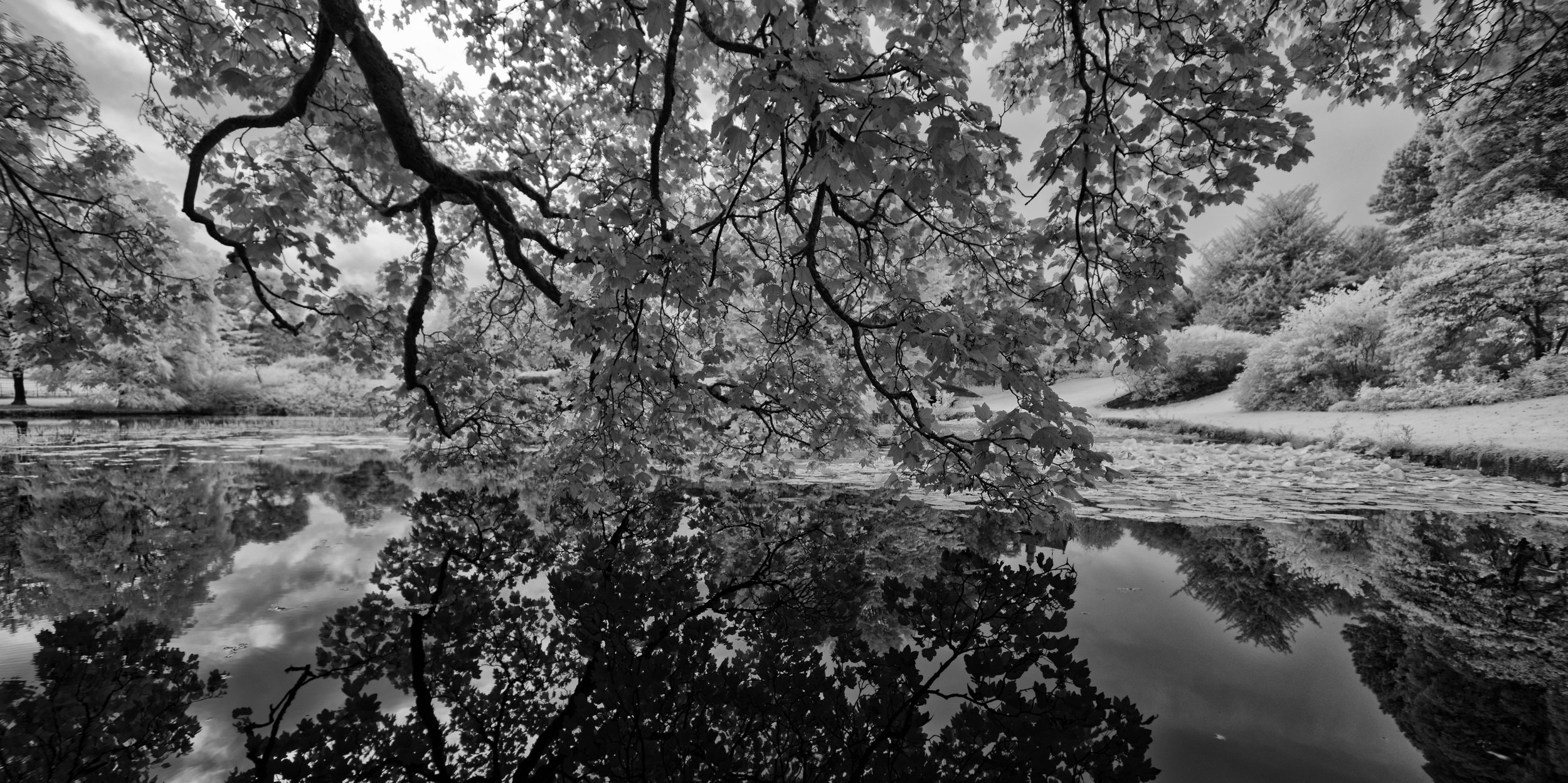
Sizergh Castle, Cumbria
Infra red photography
The first infra red photographic images were published by Robert Wood in 1910 and the method has been progressively refined since then. IR filters allow cameras to capture light at wavelengths greater than the upper limit of the visible spectrum (roughly 750 nanometres), mainly in the 550nm to 850nm range.
Most of the monochrome IR photos shown here are taken with an adapted SLR fitted with a 720nm low-pass filter i.e. a filter that lets in light with wavelengths greater than 720nm. It is possible to buy 720nm and even 850nm screw-on filters but they are almost opaque through the viewfinder hence a bit awkward to use as it’s necessary to set the focus and exposure before attaching the filter. 720nm and 850nm filters stop almost all of the visible light spectrum hence they’re mostly used in black and white photography. Images using these filters are typified by dark skies, ‘snowy’ vegetation (blue skies preferentially absorb IR whilst chlorophyll reflects it) and milky skin tones but with many other more subtle effects.
I’m also beginning to explore ‘full spectrum’ photography - removal of the camera’s internal filters such that the sensor is able to capture the entire light spectrum (well, from 200nm to 1200nm). This means that shorter wavelength low-pass filters can be used - I have 665nm, 590nm and 550nm. These filters capture the upper half of the visible wavelengths as well as infra red. Unlike the 720nm and 850nm filters they are sufficiently translucent to look through the viewfinder for composition and focus, and they also allow experimentation with myriad ‘false colour’ effects.
Black & white, 720nm
Birmingham Canal
Birmingham Canal
Warehouse, Birmingham Canal
Medicine Bakery, Birmingham
Severn estuary, near Sharpness, Gloucestershire
Charmouth beach, Dorset
Path to Golden Cap, Dorset
Dorset
Reactors, Berkeley, Severn Estuary, Gloucestershire
Cotteridge Park, Birmingham
Rey Valley wetlands, Birmingham
Carruthers' place near Gabian, Languedoc, France
Carruthers' place near Gabian, Languedoc, France
Carruthers' place near Gabian, Languedoc, France
Strourhead, Wiltshire
Stonehenge, Wiltshire
Sizergh, Cumbria
Longhorn cattle, Shugborough Estate, Staffordshire
Shuborough Estate, Staffordshire
Harvington Hall, Worcestershire
Harvington Hall, Worcestershire
Cotteridge Park, Birmingham
Torver Jetty, Coniston Water, Cumbria
Berkeley reactors, Severn Estuary, Gloucestershire
Waseley Hills Country Park, Birmingham
River Leam, Leamington Spa, Warwickshire
Clent Hills, Worcestershire
Rey Valley wetlands, Birmingham
Clent Hills, Worcestershire
Clent Hills, Worcestershire
False colour, 550nm-665nm
Reactors, Berkeley, Severn estuary, Gloucestershire, with IR Chrome filter
River Rey valley, Kings Norton, Birmingham, with IR Chrome filter
Kings Norton, Birmingham, with 720nm filter
Tardebigge locks, Worcestershire, with 550nm filter
Tardebigge locks, Worcestershire, with 550nm filter
River Rey valley, Kings Norton, Birmingham, with 720nm filter
Clent Hills, Worcestershire, with 720nm filter
Worcester and Birmingham Canal, with 665nm filter
Worcester and Birmingham Canal, with 665nm filter
Wolverley Canal, Worcestershire, with 590nm filter
Wolverley Canal, Worcestershire, with 590nm filter









































